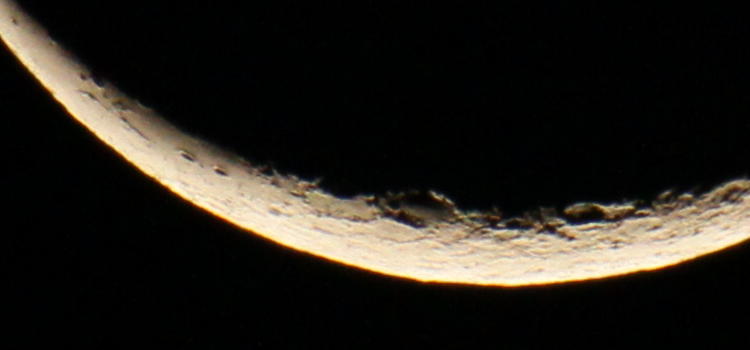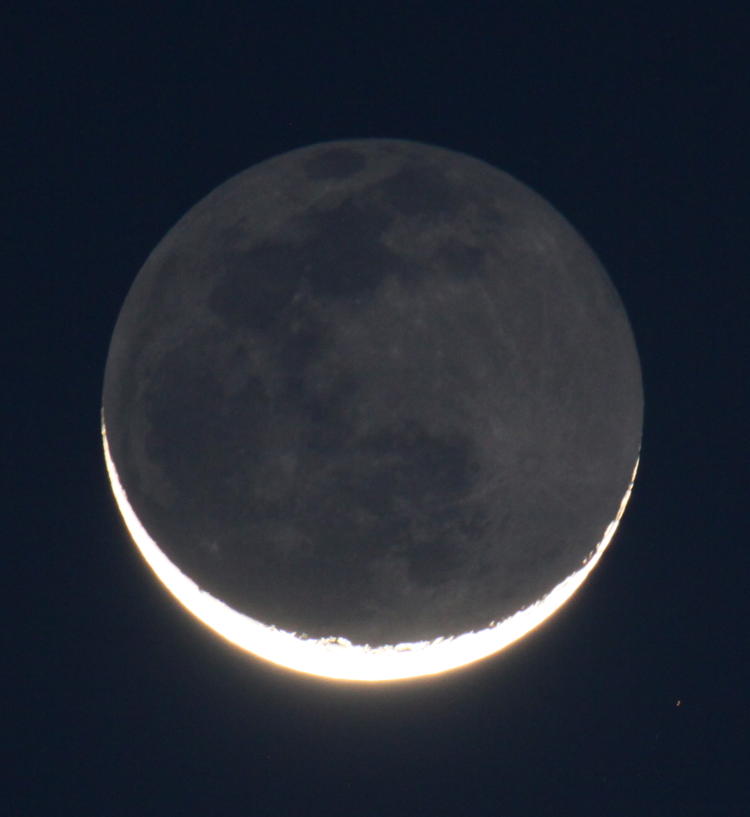Buggato has, several times, avowed that he was going to be up, having fun shooting sunrise, while I had to go into work, but somehow I never see any sunrise pics on his blog. Odd, that. But this morning, up far earlier than intended, I had my chance. Only thing is, the sky is perfectly clear and thus rotten conditions for sunrise, which needs humidity and for preference scattered high-level clouds to make things interesting. The crescent moon is up, though.

I had to take a selection of shots, both to pin down the best exposure and to pin down the best focus. Even at 600mm, the moon is small enough in the sky, and dim enough, that precise focus is very tricky, and it takes perfect focus to get the best details from the terminator, so focus and exposure bracketing were both necessary. This was the closest I got – potentially could be better, but certainly brings out some highlights. We’ll go in for a closer look at this same frame.

This is full-resolution, at ISO 800 so we have a little colorful noise sneaking in. The shallow crater in the center, just seeing sunset on the edge at top, is most likely Grimaldi, which would make the crater to its right Darwin – it’s hard to tell when everything is on its side and I’m not sure where we are in the precession that the moon performs, but that seems to fit. The two distinct, smaller craters to the left are Krafft (L) and Cardanus (R).
But that’s not all we have this morning. The earthshine was very distinct, though capturing that required a different exposure entirely.

This is a one-second exposure at f6.3, ISO 800, which is long enough at this magnification to start to introduce motion blur, but just barely. Since the details lit by the light reflected from Earth (not where I was, but further east where it was daylight,) are still dim, bringing them out requires much long shutter speeds and the Earth still refuses to stop spinning, so there’s a limit, especially if you’re working without a tracking mount. And yes, I’ve talked about them before, but here’s the crucial bit: even if I had a tracking mount, it’d have to be precisely aligned to celestial north (Polaris, only not exactly,) and that would take a lot of fussing for a couple of shots to feature on the blog – I’d probably not bother anyway. But even with this, the details, especially the ray craters of Tycho, came out more than adequately.
You may notice a brighter spot at lower left, not too far from the terminator, and think that’s a little too bright, as I did. But no, that’s Aristarchus, a quite young crater at only 450 million years, so it’s naturally pretty bright – actually, the brightest thing on the moon. Were it actually lit by sunlight, the light would be so bright as to burn a hole in your retina, so it’s a good thing we’re only seeing it in relative darkness.
Okay, no.
In a couple of days, the moon will be down to a little over one percent illuminated right before sunrise, and will diminish down to about 0.8 percent by two PM – we’ll have to see if I make the attempt then, and what I get. Unless we have some specific conditions, it will likely be obscured just from sunlight scattered by the atmosphere but, well, time will tell…



















































